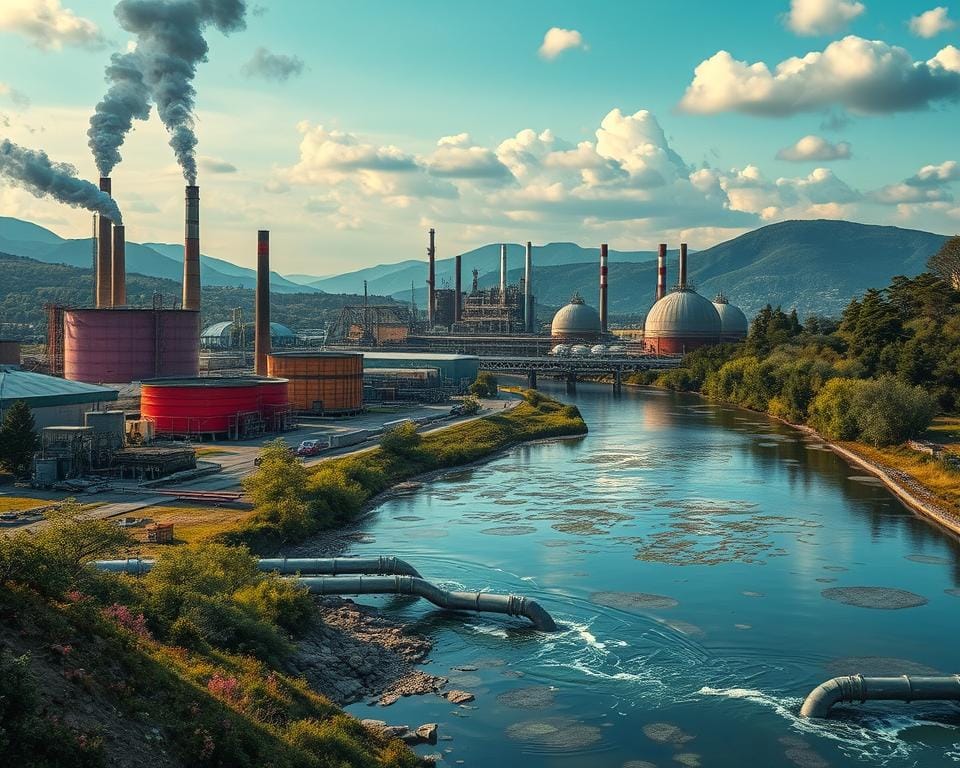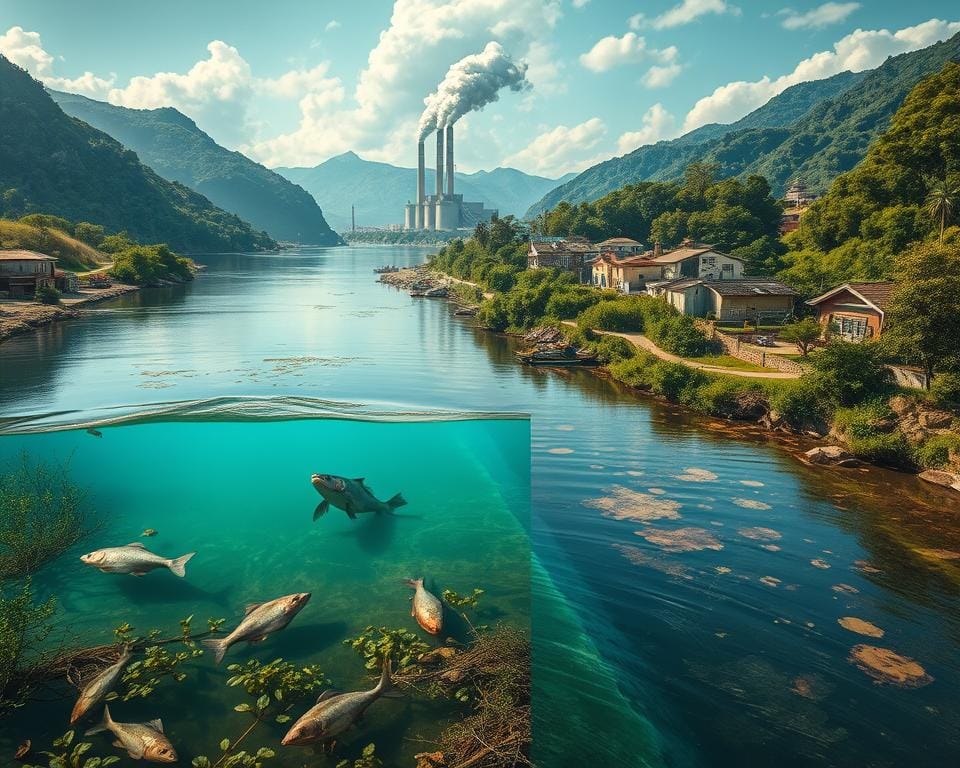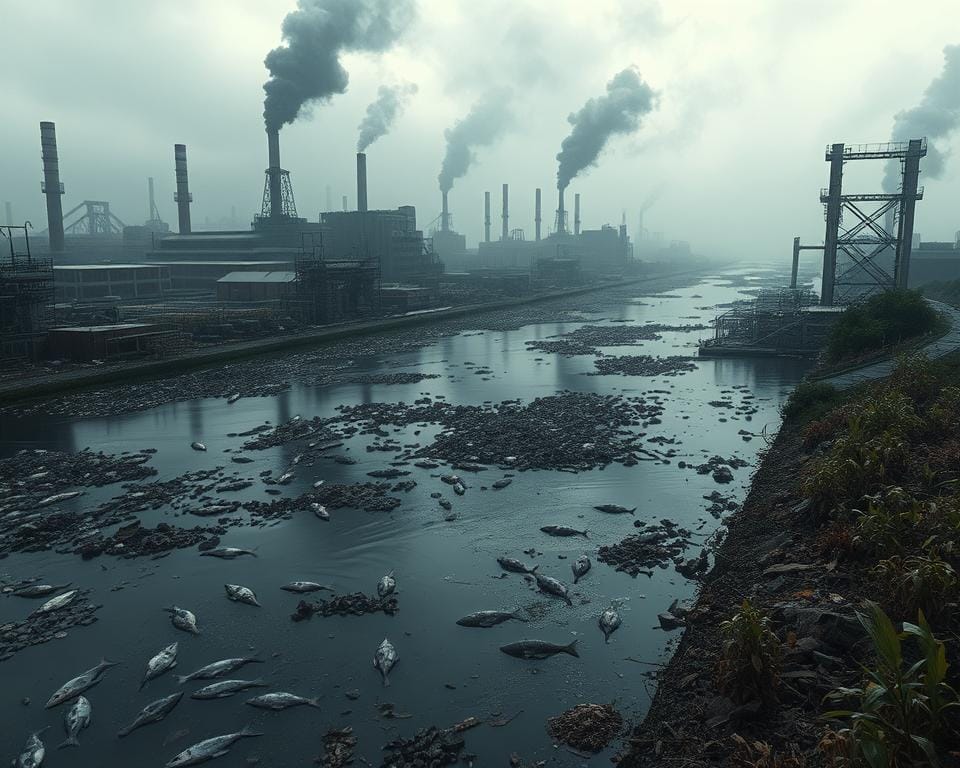When we talk about industrial pollution, it’s hard to overlook the damage to our environment and water. Pollutants like organic carbon, nitrogen, and heavy metals are released into our waters. This harms numerous ecosystems and natural resources worldwide.
Despite efforts, most of Europe’s waters are not in good condition. Only 40% of surface waters are ecologically sound, and 35% are chemically safe. The EU has laws like the Water Framework Directive to improve water quality. But, monitoring pollutants and preventing eutrophication remain big challenges.
The industry’s value in Europe grew 20% despite the pandemic. This shows we can have both economic growth and fewer emissions. For more on managing water better, see this [valuable resource].
Understanding the Causes of Industrial Water Pollution
Industrial activities lead to water pollution, a major environmental worry. By learning about the different kinds of industrial waste and understanding runoff and discharge, we can find better ways to fight this problem.

Types of Industrial Waste
Different industries create various wastes, polluting water. These wastes include:
- Solid Waste: Things like plastics and metals which aren’t biodegradable. When thrown away carelessly, especially in developing nations, they pollute water.
- Toxic Waste: Industrial wastewater has deadly substances, like radioactive or cancer-causing materials. These pollute water bodies.
- Chemical Waste: Mismanaged solvents and chemicals can seriously pollute water. This causes health dangers.
If not managed well, this waste harms water quality a lot. For instance, millions of tons of plastic waste enter oceans, leading to microplastics in sea creatures and even our food.
Effects of Runoff and Discharge
Runoff and discharge from industries affect water bodies profoundly. Runoff can carry soil and sediment, hurting ecosystems and aquatic life. Discharges, like hot water from power plants, lower water’s oxygen levels. This affects fish, making it hard for them to survive.
Oil spills and runoff from roads damage aquatic life and coastlines deeply. Sometimes, businesses illegally dump dangerous chemicals into the ground or sewers. This leads to massive water pollution and serious health problems.
| Source | Type | Impact |
|---|---|---|
| Domestic Sewage | Pathogens, organic waste | Causes pollution, a big issue in developing countries |
| Plastic Waste | Solid Waste | Results in microplastics in marine life and ecosystems |
| Industrial Wastewater | Toxic, chemical waste | Contaminates water with deadly and radioactive substances |
| Soil Erosion | Sediment | Disrupts life in water and reproductive cycles |
| Oil Runoff | Petroleum pollutants | Damages life in water and along coastlines |
Effects of Industrial Water Pollution on Health and the Environment
Industrial water pollution harms human health and the environment. It affects our drinking water and ecosystems.

Human Health Impacts
Water pollution leads to diseases like cholera and hepatitis A. These diseases can cause deaths. Polluted water can also cause cancer and neurological disorders.
- Gastrointestinal issues
- Respiratory problems
- Skin infections
- Life-threatening diseases
Pathogens in water increase waterborne diseases. This puts public health at risk.
Environmental Consequences
Pollution damages water bodies with heavy metals and other toxins. It lowers oxygen levels, affecting fish and other marine life. Animals dependent on these environments suffer too.
Industrial pollution introduces toxins into the food chain. It also leads to excessive nutrients in water, causing algal growth and dead zones.
| Source of Pollution | Pollutants Released | Environmental Impact |
|---|---|---|
| Manufacturing Plants | Heavy Metals, Organic Pollutants | Harm to Aquatic Life, Ecosystem Disruption |
| Mining Operations | Heavy Metals, Inorganic Substances | Water Contamination, Soil Degradation |
| Power Plants | Thermal Pollution, Trace Metals | Altered Water Temperature, pH Imbalance |
| Chemical Industries | Organic Pollutants, Heavy Metals | Toxicity to Marine Life, Algal Blooms |
| Agricultural Industries | Biological Pollutants, Sediments | Eutrophication, Dead Zones |
| Textile Industries | Dyes, Solvents, Heavy Metals | Water Discoloration, Toxicity |
We need to act quickly to tackle water pollution. The health of humans and the planet is at stake. Adopting sustainable practices and strong policies is crucial.
The Role of Legislation in Controlling Industrial Water Pollution
Legal frameworks are crucial for regulating industrial water pollution. The Clean Water Act (CWA) is a key law in this area. It was passed in 1972, updating the Federal Water Pollution Control Act of 1948. Its goal is to stop water pollution and keep the nation’s waters healthy. This is done by requiring permits for discharging pollutants through the NPDES program.
In the 1960s, water pollution became a big issue. For instance, the Potomac River received 240 million gallons of sewage waste daily. This problem led to tougher policies to control pollution from specific sources, like factory pipes. The EPA uses the CWA to set water quality rules, create standards, and give out permits to industries and cities.
The CWA has been updated several times—in 1977, 1981, 1987, and 2014. These changes address pollution from both direct and scattered sources. Section 319 deals with scattered pollution, like farm runoff. Section 404 looks at the impact of dumping materials into waters, affecting places like wetlands.
The Clean Water State Revolving Fund (CWSRF) started in 1987. It gives money to communities to improve wastewater treatment. This reflects a strong dedication to strict water quality rules. The law also includes firm penalties for breaking its rules. For instance, the Colonial Pipeline Company was fined $30 million in 2000 for violations.
In the mid-1990s, cities like Los Angeles, Miami, and Cincinnati had issues with sewage harming water quality. Now, there’s a focus on stormwater runoff from big construction sites. This has led to legal action against corporations like Wal-Mart and Target for not following the rules.
Clean water laws are always changing to better protect our water. They play a vital role in keeping our water safe. For deeper understanding, check out this guide on water quality management.
Strategies for Reducing Industrial Water Pollution
To fight water pollution from industries, we need many strategies. These methods help improve water quality by cutting down pollutants. It’s vital to use industrial water treatment, eco-friendly tech, and environmental checks for sustainability.
Wastewater Treatment Systems
Setting up advanced water treatment systems in industries is a key strategy. These systems clean water by removing pollutants. This makes the water safe to release back or reuse. Technologies like membrane bioreactors and reverse osmosis are very effective. They play a big role in saving water, supporting public health, and helping nature and the economy grow sustainably.
Adoption of Green Technologies
Using green technology also helps reduce water pollution. These technologies cut down on harmful chemicals. That means our environment suffers less. Methods like bioremediation use tiny organisms to clean water. Nanotechnology can take out heavy metals. These new solutions prove technology can solve tough environmental problems.
Environmental Audits and Collaboration
Environmental audits help find where pollution comes from and its effects. These checks make sure companies meet legal standards and better their practices. Also, working together with groups like NGOs and companies is critical. Cases like the Hudson and Thames rivers show how teamwork can clean our waters.
To truly reduce industrial water pollution, we need many approaches. This includes better treatment systems, using green tech, doing regular checks, and working together. This way, we can keep our environment safe for the future.
Conclusion
Water is very important to us and we all need to work together to protect it. We learned that industries play a big role in water pollution. They add more than half of the harmful stuff found in our rivers. To fix this, industries need better ways to clean their wastewater. They should also follow green practices and check their environmental impact often.
Being sustainable means not just following rules, but also using clean technology and checking our impact regularly. Working together with communities and those who make laws is key. This helps make strong plans for keeping water clean. Since farming and sewage add to pollution too, we need to look at all sources. We should all try to lower pollution by living more sustainably and improving our sewage systems.
Making the environment better is good for everyone. But we have to do it together. Studies show that most water is not safe for fish because of toxins, which is bad for the environment and us. If we focus on green practices and saving water, we can keep our waters clean. Let’s keep pushing forward with smart ideas to make sure our world stays clean and safe.

